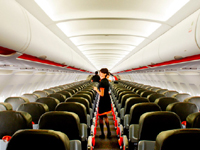Airlines may double their prices
Airlines have been able to raise prices jointly all year and still keep seats filled at record levels. But there are now early signs that the market may undergo considerable changes. Air travel demand, it appears, may finally be falling as fare increases and fuel charges rise up.

For travelers, the impact can be boiled down simply to this: look for fare sales on select routes and other promotions as airlines, desperate for cash, react to demand that may be declining faster than their ability to shrink the system. And expect further cuts in air service, especially in some small and medium-size cities because airlines are no longer willing to pay the price of feeding traffic to their hubs — which is how the major airlines make money.
“If there is a push back, it’s going to happen in waves, starting first with leisure travel, followed later by business travel,” said Rick Seaney, the founder and chief executive of FareCompare.com, a travel Web site that closely tracks airline pricing.
Everybody who follows the industry is looking hard at the operational data that the airlines released for April. All year, as they have raised prices, most airlines have been cutting back on domestic seating capacity. At the same time, they have been reporting that load factors — the percentage of available seats filled with paying customers — were at record levels of 80 percent and higher.
But in April, for the first time in well over a year, airlines reported that their loads had dropped off compared with the previous April. Some, but not all, of this can be attributed to Easter’s falling in March this year.
As in baseball, the fine print statistics speak volumes. In April, American Airlines had 8.4 percent fewer domestic passenger miles flown on 5.9 percent fewer seats than April 2007. United Airlines had 9.5 percent fewer domestic passengers in 6.5 percent fewer seats. The other four so-called legacy carriers — Delta, Continental, Northwest and US Airways — all reported declines in domestic traffic that exceeded their declines in domestic capacity.
At the same time, the major airlines have all been adding seats to the more lucrative international routes. By summer, Delta has said, more than 40 percent of its total capacity will be on international flights.
On the other hand, Southwest Airlines, which has been expanding steadily, had 3.9 percent more passengers despite a 5.3 percent increase in seats, with a relatively roomy load factor of 72.3 percent (virtually unchanged over April 2007).
Looking ahead, Mr. Seaney sees even more reductions in seats on domestic flights if oil prices keep rising. “If oil gets up to $140 or $150, we may be looking at another cutback in capacity of 15 percent by the end of the year,” he said.
“Consumers absolutely have to start changing their buying behavior in air travel” and shop as far in advance as possible, while taking advantage of bursts of sales, Mr. Seaney said.
Subscribe to Pravda.Ru Telegram channel, Facebook, RSS!


